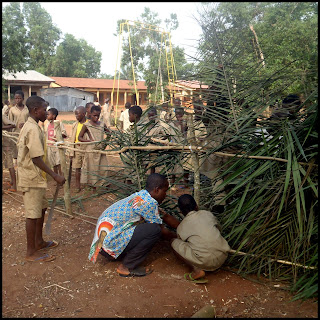So
what am I actually doing with my host organization?
The
Maraichers and also my Bureau at CeCPA requested me
here for two main reasons. They had irrigation problems, and they
have a desire to diversify the crops that they are growing.
The
volunteer who I replaced here in Misserete did a great job getting
Irrigation Systems installed in two of the farms where I work. I
might eventually work on getting Irrigation to one or two other
groups.. but in the mean time we are focusing in on crop
diversification.
The
BIGGEST problem with crop diversification has not proven to be
getting the seeds or teaching the farmers how to grow these new
crops.. the biggest problem has been what to do with these crops once
they are grown. People are creatures of habit, and the women who work
in the farms are more interested in selling these new crops to the
posh city people then actually eating them themselves. AND right now
the vendors in the markets in Porto Novo get their carrots,
cucumbers, eggplants, cabbages.... etc. imported in from Cotonou (and
where ever they come from before that). Or you can go to Songhai to
buy the more “exotic” vegetables. So how do we get people to know
that the farmers in the area are now growing these things too?
Currently
the women are known for growing almost entirely legumes (assorted
African leafy greens) and the vendors in the market will send a zemi
or another person out to the farm to pick up a plonch worth for them
to sell that day.. that is the extent of communication between the
farmers and the vendors. So last year.. when they tried some new
crops.. they weren't able to sell them.
After
throwing some various ideas around what it seems that the maricheres
group really wants is a place to advertise and a place not too far
from the farms (as in not in Porto Novo or in an actual market) where
they can sell some of the new vegetables themselves. So we are
talking about building a small market stand on the CeCPA office
property.. right next to the ONASA (where people already come to buy
(and store) their grains in bulk through out certain parts of the
year).. where the women can advertise and vend some of their new
produce. The agreement is that if we do this project for them than
the office (because it is on CeCPA property) will be in charge of the
security and upkeep of the “barrack” and the woman’s farming
groupement organization will be in charge of keeping it manned.
I
really hope that I am able to get the logistics of this project
sorted out soon.. I am very hesitant to have the women start growing
these crops again.. when they still don't have a plan for selling
them. I don't want them to become overly discouraged and am worried
about their capacity to want to try again if it fails.. when they
could be using that same land to grow their legumes.
Aside
from allowing the farmers to be able to diversity their goods.. in
turn making them more marketable to the outside vendors.. and
eventually more financially secure. This food stand will also help by
providing more a more varied diet to the local communities. Right now
the families who know how to cook these “newer” vegetables go to
Porto Novo to buy them. It is my hope that with these vegetables
available locally a greater variety of local Beninese people will
start to eat them as well.
Like
I said, the planning for this is still in the preliminary stages so
it will be interesting to see how it progresses.. things move very
slow in this country and the project keeps getting larger in ways that I don't completely understand (I just wish I actually felt like I was helping
the women that I came here to work with).
I
will be going to a training in March on Nutrition Education, and I
have hope that [aside from Moringa] getting locals to eat a more
varied diet will be something that we cover.
Z



